
Wetenschap
Water, overal water:polarisatie heeft een dramatische invloed op de H2O-structuur die wordt onthuld door simulatie van moleculaire dynamica
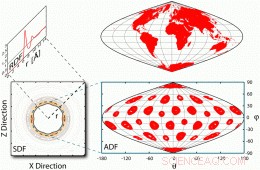
Verschillende distributiefuncties van een watermolecuul. Drie verschillende manieren om de volgorde van water O- en H-atomen rond C60 of elke opgeloste stof te meten. Het meest voor de hand liggend is de driedimensionale ruimtelijke distributiefunctie (SDF) die de dichtheid weergeeft bij elk volume-element gecentreerd op elk punt in de ruimte gedefinieerd door coördinaten (x, ja, z). Het lijdt aan de ernstige moeilijkheden die gepaard gaan met het bekijken en analyseren van een algemene driedimensionale kaart. De meest gebruikte is de eendimensionale radiale distributiefunctie (RDF) die het aantal O- of H-atomen over alle volume-elementen op een afstand r van het centrum van C60 gemiddeld, waarbij r2 Ľ x2 þ y2 þ z2. Hoewel een dergelijke middeling de signaal-ruisverhouding verhoogt, de RDF verbergt veel kenmerken van de driedimensionale dichtheidskaart. Geconfronteerd met deze beperkingen, introduceren we de azimutale distributiefunctie (ADF) die dichtheidskaarten berekent in dunne bolvormige schalen bij een bepaalde r-waarde in termen van sferische poolcoördinaten (r, ik, ). De resultaten, die alle opvallende driedimensionale kenmerken van C60 presenteren, kunnen gemakkelijk op papier worden bekeken met behulp van de Sanson-Flamsteed-projectie (69) die door vroege cartografen werd gebruikt. © PNAS, doi:10.1073/pnas.1110626108
(PhysOrg.com) -- Water is essentieel voor meer dan zijn talloze rollen in biologische, chemisch, geologisch, en andere fysieke processen. Een nauwkeurige beschrijving van water hebben structuur is van cruciaal belang voor het construeren van nauwkeurige simulaties van moleculaire gebeurtenissen, inclusief eiwitvouwing, substraat binding, macromoleculaire herkenning, en complexe vorming. Een belangrijke stap voorwaarts in het creëren van een dergelijke beschrijving is aangetoond aan de Stanford University School of Medicine, waar onderzoekers ontdekten dat polarisatie de geordende waterstructuur verhoogt. Hun bevindingen zullen een aanzienlijke impact hebben op biologische processen.
Dr. Gaurav Chopra en professor Michael Levitt van de afdeling structurele biologie gebruikten moleculaire dynamica-simulaties met behulp van een ultramodern Quantum Mechanical Polarizable Force Field (QMPFF3) om de hydratatie van buckminsterfullereen te bestuderen, de kleinste hydrofobe nanosfeer die algemeen wordt aangeduid als een buckyball of C 60 . (Hydrofobe moleculen zoals fullerenen worden afgestoten door water, en hebben de neiging zowel niet-polair als elektrisch neutraal te zijn.)
Er waren veel uitdagingen die moesten worden overwonnen bij het ontwerpen en implementeren van op QMPFF3 gebaseerde moleculaire dynamica-simulaties - vooral om het gedrag van watermoleculen naast hydrofobe oppervlakken te bestuderen met atomaire details en een tijdresolutie van subpicoseconden. “De eerste was de noodzaak om een geschikt polariseerbaar krachtveld te gebruiken, ’, legt Chopra uit. “Er zijn er meerdere – bijvoorbeeld AMOEBE, polariseerbare versies van OPLS, AMBER, en CHARMM - maar deze zijn allemaal empirisch omdat ze zijn geparametriseerd om te passen in experimentele gegevens zoals voor het eerst uiteengezet door Warshel en Lifson in een paper uit 1968 waarin hun consistent krachtveld . We wilden een ab initio krachtveld gebruiken dat minder gevoelig zou zijn voor willekeurige parametrering.” Hoewel een dergelijk krachtveld was ontwikkeld door Algodign, LLC in Moskou, het was niet academisch beschikbaar. Echter, door drie jaar geleden Algodign in Rusland te bezoeken, en met de tussenkomst van Levitt, ze verkregen academische rechten.
“We zijn begonnen met het aanpassen van het QMPFF3-programma, AlgoMD, om te werken aan de meerdere kernen op onze Linux-supercomputer (BioX 2 )” gaat Chopra verder. "Vervolgens moesten verschillende tests worden uitgevoerd om de juiste set-up van het evenwichtsprotocol te krijgen met de juiste set parameters voor normale temperatuur- en drukregeling, samen met de meest relevante selectie van het atoomtype voor de buckyball om te gebruiken. Het kiezen van het optimale testsysteem was eenvoudig, aangezien het Levitt-lab eerder aan dit molecuul had gewerkt met niet-polariseerbare empirische krachtvelden.”
De laatste uitdaging was om een methode te vinden om de waterstructuur rond buckyball te visualiseren. "De meest populaire methode om de waterstructuur rond een opgeloste stof te bestuderen, gebruikte een eendimensionale radiale distributiefunctie die het aantal water O- en H-atomen op een bepaalde afstand gemiddeld om de signaal-ruisverhouding te vergroten, ', legt Chopra uit. "Deze eendimensionale radiale distributiefunctie verbergt veel kenmerken van de driedimensionale dichtheidskaart rond elke willekeurig gevormde opgeloste stof. Geconfronteerd met deze beperkingen en om rekening te houden met de voetbalsymmetrie van C 60 we introduceerden de Azimutale distributiefunctie om de O- en H-dichtheid te visualiseren die is verdeeld zoals deze is in concentrische bolvormige schalen.
Om deze uitdagingen aan te gaan, het team was afhankelijk van een lange geschiedenis van gerelateerd onderzoek. “Sinds het baanbrekende werk op het consistente krachtveld dat meer dan 50 jaar geleden door Shneior Lifson werd ontwikkeld, het model van een atoom was een kern met een gedeeltelijke lading. Wij geloven dat de tijd is gekomen om over te gaan naar een meer realistische weergave van een atoom als een kern en een exponentieel verdeelde nulmassa elektronenwolk eromheen.” Door de implementatie van deze weergave in QMPFF3 kon het effect van polarisatie correct worden gemodelleerd. We studied the structure of polarized water around polarized Buckminsterfullerene to show that polarization induces a strong hydrophobic effect; this has been under-represented by the limitations due to approximate modeling of atomic interactions in the empirical force fields widely used for the past decades.
The sensitivity of their novel method for detecting surface roughness shows that the hydrophobic effect is much stronger at short- and long-range for QMPFF3 compared to empirical force fields simulations. Om deze reden, QMPFF3 is expected to have a profound effect in understanding key biological processes like protein folding. Using a novel and highly sensitive method to measure surface roughness and detect water ordering, we show that accurate modeling of solute and solvent polarization results in a stronger hydrophobic effect, Chopra summarizes.
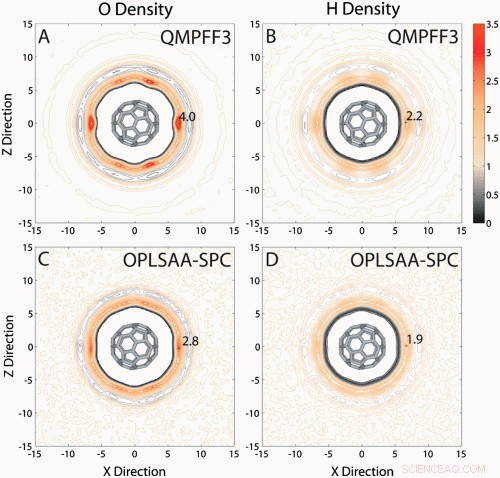
SDFs (QMPFF3 vs. empirical force field). SDFs for water oxygen (O) and hydrogen (H) density around C60 for (A and B) QMPFF3 and (C and D) OPLS-AA with SPC water (OPLSAA-SPC). The orange contours represent higher O and H atom density, and black contours represent lower density than bulk. Both OPLSAA-SPC and QMPFF3 have an excluded volume around C60, a layer of low water density, and well-defined first and second water hydration shells. QMPFF3 water shells around C60 are more structured in radial and azimuthal direction with well-defined peaks; there is no structure apparent in the azimuthal direction for OPLSAA-SPC. The ratio of highest O to H density was 1.4 for OPLS-AA with SPC water and 1.8 for QMPFF3. © PNAS, doi:10.1073/pnas.1110626108
Apart from the azimuthal distribution functions developed to analyze the results, another challenge was to make suitable choices in the simulation protocol to significantly enhance the physical reality of the C 60 water system. The van der Waals equivalent for QMPFF3 is the combination of exchange and dispersion terms in QMPFF3. We used aromatic atom types for C 60 that were reparameterized by simple model correction using coupled-cluster with single and double and perturbative triple excitations data in QMPFF3. We also used long-range dispersion correction terms for total energy and pressure caused by truncation of dispersion forces. Chopra stresses that the study was computationally very intensive, and would not have been possible without the National Science Foundation-supplied BioX 2 supercomputer.
Chopra also points out that while QMPFF3 is one of the best polarizable force fields available today, as it is a general purpose ab initio force field which has been parameterized using only quantum mechanical data to successfully reproduce the experimental data for a large array of chemical compounds in all three phases of matter, it is not perfect. We can reparameterize certain special atom types using a higher level and more accurate quantum mechanical data as well as introduce new atom types for specific applications. The functional form may also need to be modified to further increase the physically realistic representation of the non-bonded parts of the force field currently modeled as dispersion, exchange, electrostatics and induction, he notes. These advances could significantly improve the performance of this state-of-the-art polarizable force field.
Anderzijds, Chopra points out, By adapting the QMPFF3 program on GPUs one could significantly increase its computational performance to study much larger systems of interest at biologically relevant timescales. Based on our tests, QMPFF3 is about 10 times slower than the empirical force field simulations to study protein-water systems on commodity clusters. We therefore think it is important to make advances to simultaneously improve the physical reality as well as increase the computational efficiency of the current state-of-the-art polarizable force field.
Chopra sees the teams findings as relevant to a wide range of possible applications. Our work is at the intersection of material science, nanotechnology and fundamental interactions in protein folding. The nature of the hydrophobic effect forms the basis of protein folding simulations and fullerenes are perfect model systems to study the affect of such interactions. Bovendien, polarization has always been neglected or modeled incorrectly but our results show the importance of polarization resulting in stronger short- and long-range hydrophobic interactions.
Chopra acknowledges that while their findings are not directly applicable to the development of fullerene-based biosensors as such, biosensors are made using water-soluble fullerene derivatives. Having discovered the correct way to include of polarization for your system of interest to make it physically realistic could significantly advance the selection of suitable groups to be attached to fullerenes for many applications, including biosensors, as well as for significantly advancing the process of drug discovery. Our result can be used as a quick way to include the effect of the arrangement of water molecules based on the surface topology of a hydrophobic binding pocket. In het algemeen, the accurate treatment of polarization to include the affect of solvent in the binding pocket will potentially be useful for advancing computational drug design. Chopra is also very interested to study the effect of polarization on biological systems like proteins in non-homogenous solvent simulations.
Ours is a very general technique and any system can be studied with the simulation and analysis methods of this paper, Chopra concludes. Since QMPFF3 is a general-purpose polarizable force field and, for studying any system, it gives a physically realistic treatment to include polarization, which is essential for any biological system as they are always present in a polar medium like water. Also, our method to study water structure is a significant advance over currently used techniques and should be used to visualize water structure around any arbitrary shaped solute.
Copyright 2011 PhysOrg.com.
Alle rechten voorbehouden. Dit materiaal mag niet worden gepubliceerd, uitzending, geheel of gedeeltelijk herschreven of herverdeeld zonder de uitdrukkelijke schriftelijke toestemming van PhysOrg.com.
 Biodiversiteit het hoogst op inheems beheerd land
Biodiversiteit het hoogst op inheems beheerd land Afbeelding:Hurricane Lane
Afbeelding:Hurricane Lane Nauwkeurigere metingen tonen aan dat het smelten van ijs op West-Antarctica versnelt
Nauwkeurigere metingen tonen aan dat het smelten van ijs op West-Antarctica versnelt Diepe ondergrondse krachten verklaren aardbevingen op San Andreas Fault
Diepe ondergrondse krachten verklaren aardbevingen op San Andreas Fault Wetenschappers onthullen een nauw verband tussen luchttemperatuur en het gebied van Antarctische polynyas
Wetenschappers onthullen een nauw verband tussen luchttemperatuur en het gebied van Antarctische polynyas
Hoofdlijnen
- Waarom het zo moeilijk is om schepen bij te houden die niets goeds doen?
- Wat zijn de spoelen van DNA in de kern?
- De delen van een gistcel
- Onderzoeker koppelt zalmseks aan geologische verandering
- Het belang van plantaardige cellen
- Waarom zijn we gewelddadig?
- Wilde zwijnengif veldtesten in Texas, Alabama in 2018
- Onderzoek bevestigt het:we worden echt dommer
- Hoe schimmels fruitvliegen manipuleren om sporen te ontvangen en vrij te geven?
- Antilichamen inhuren als bouwers van nanotechnologie
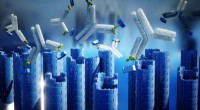
- Vooruitgang in nanotech gene sequencing-techniek
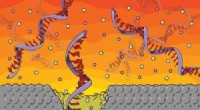
- Gouden nanodeeltjeskettingen zijn veelbelovend als lichtgeleiders
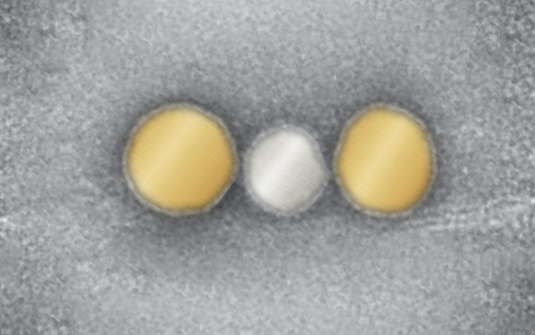
- Licht verplaatsen over een halfgeleidende nanodraad via akoestische oppervlaktegolven
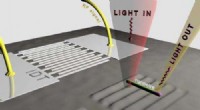
- Nieuwe technologie maakt nauwkeuriger zicht op de kleinste nanodeeltjes mogelijk

 Een organisch halfgeleidermysterie oplossen
Een organisch halfgeleidermysterie oplossen ESO maakt tot nu toe beste beelden van eigenaardige asteroïde van hondenbeen
ESO maakt tot nu toe beste beelden van eigenaardige asteroïde van hondenbeen Thermisch geleidende polyimidefilm:een betere manier om warmte in elektronische apparaten af te voeren
Thermisch geleidende polyimidefilm:een betere manier om warmte in elektronische apparaten af te voeren Video:Sublieme geheimen van sushi
Video:Sublieme geheimen van sushi Google Assistent voegt meer talen toe in wereldwijde push
Google Assistent voegt meer talen toe in wereldwijde push Onderzoek naar aardgasopslag kan opwarming van de aarde tegengaan
Onderzoek naar aardgasopslag kan opwarming van de aarde tegengaan Diepe diamanten bevatten bewijs van recyclingprocessen in de diepe aarde
Diepe diamanten bevatten bewijs van recyclingprocessen in de diepe aarde Hoe herstel van de impact van COVID-19 op de energievraag kan helpen om de klimaatdoelstellingen te halen
Hoe herstel van de impact van COVID-19 op de energievraag kan helpen om de klimaatdoelstellingen te halen
- Elektronica
- Biologie
- Zonsverduistering
- Wiskunde
- French | Italian | Spanish | Portuguese | Swedish | German | Dutch | Danish | Norway |

-
Wetenschap © https://nl.scienceaq.com

